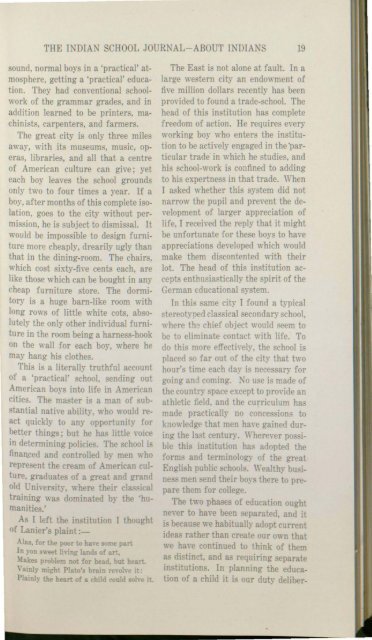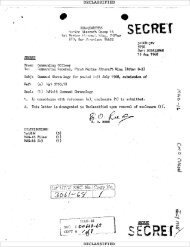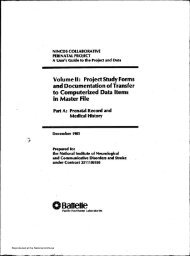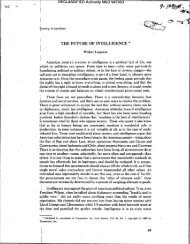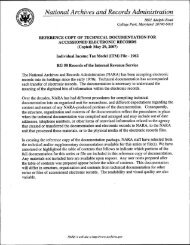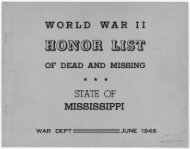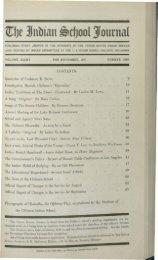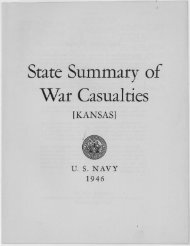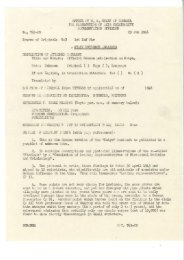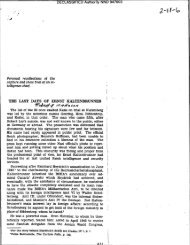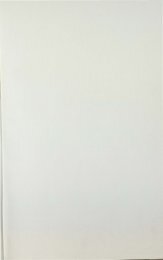the indian school journal - National Archives and Records ...
the indian school journal - National Archives and Records ...
the indian school journal - National Archives and Records ...
You also want an ePaper? Increase the reach of your titles
YUMPU automatically turns print PDFs into web optimized ePapers that Google loves.
THE INDIA SCHOOL JOUR 'AL-ABOUT INDIANS 19<br />
sound. normal boys in a 'practical' atmosphere,<br />
getting a 'practical' education.<br />
They had conventional <strong>school</strong>work<br />
of <strong>the</strong> grammar grades, <strong>and</strong> in<br />
addition learned to be printers. machinists,<br />
carpenters, <strong>and</strong> farmers.<br />
The great city is only three miles<br />
away, with its museums, music, operas,<br />
libraries, <strong>and</strong> all that a centre<br />
of American culture can give; yet<br />
each boy leaves <strong>the</strong> <strong>school</strong> grounds<br />
only two to four times a year. If a<br />
boy, after months of this complete isolation,<br />
goes to <strong>the</strong> city without permission,<br />
he is subject to dismissal. It<br />
would be impossible to design furniture<br />
more cheaply, drearily ugly than<br />
that in <strong>the</strong> dining-room. The chairs,<br />
which cost sixty-fil'e cents each. are<br />
like those which can be bought in any<br />
cheap furniture store. The dormitory<br />
is a huge barn-like room with<br />
long rows of little white cots, absolutely<br />
<strong>the</strong> only o<strong>the</strong>r individual furniture<br />
in <strong>the</strong> room being a harness-hook<br />
on <strong>the</strong> wall for each boy, where he<br />
may hang his clo<strong>the</strong>s.<br />
This is a literally truthful account<br />
of a 'practical' <strong>school</strong>. sending out<br />
American boys into life in American<br />
cities. The master is a man of substantial<br />
natil'e ability. who would react<br />
quickly to any opportunity for<br />
better things; but he has little I'oice<br />
in determining policies. The <strong>school</strong> is<br />
financed <strong>and</strong> controlled by men who<br />
represent <strong>the</strong> cream of American culture.<br />
graduate;; of a great <strong>and</strong> gr<strong>and</strong><br />
old Gnil·ersity. where <strong>the</strong>ir classica:<br />
training was dominated by <strong>the</strong> 'humanities.'<br />
As I left <strong>the</strong> institution I thoul!'ht<br />
of Lanier's plaint;-<br />
Ala>. for <strong>the</strong> poor to have some part<br />
In y~n :-weet !:nng l<strong>and</strong>s of art,<br />
~Iakes problem not for head, but heart.<br />
\'ainly mil!ht Plato', brain renl"e it<br />
Plainly <strong>the</strong> heart of a child could sol"e it.<br />
The East is not alone at fault. In a<br />
large western city an endowment of<br />
five million dollars recently has been<br />
provided to found a trade-<strong>school</strong>. The<br />
head of this institution has complete<br />
freedom of action. He requires el'ery<br />
working boy who enters <strong>the</strong> institution<br />
to be actil'ely engaged in <strong>the</strong> "particular<br />
trade in which he studie~, <strong>and</strong><br />
his <strong>school</strong>-work is confined to adding<br />
to his expertness in that trade. When<br />
I a;;ked whe<strong>the</strong>r this system did not<br />
narrow <strong>the</strong> pupil <strong>and</strong> prevent <strong>the</strong> dewlopment<br />
of larger appreciation of<br />
life. I received <strong>the</strong> reply that it might<br />
be unfortunate for <strong>the</strong>se boys to hal'e<br />
appreciations developed which would<br />
make <strong>the</strong>m discontented with <strong>the</strong>ir<br />
lot. The head of thi~ institution accepts<br />
enthusia~tically <strong>the</strong> ~pirit of <strong>the</strong><br />
German educational system.<br />
In thi< ~ame city I found a typical<br />
stereotyped cla~;;ical ~econdary <strong>school</strong>.<br />
where tho chief object would seem to<br />
be to eliminate contact with life. To<br />
do this more effectively. <strong>the</strong> <strong>school</strong> is<br />
placed so far out of <strong>the</strong> city that two<br />
hour'~ time each da)' is necessary for<br />
going an~ coming. _-0 use is made of<br />
<strong>the</strong> counlr)' space except to prol'ide an<br />
athletic fleld. <strong>and</strong> <strong>the</strong> curriculum has<br />
made practically no concessions to<br />
knowledgp that men hal'e gained during<br />
<strong>the</strong> !lst century. Wherel'er possible<br />
thi~ in~titution ha~ adopted <strong>the</strong><br />
forms <strong>and</strong> terminology of <strong>the</strong> great<br />
English public schooh-. Wealthy bu. i<br />
nes> men send <strong>the</strong>ir boy <strong>the</strong>re to prepare<br />
<strong>the</strong>m for college<br />
The two phases of education ought<br />
never to hal'e been separated, <strong>and</strong> it<br />
is because we habitually adopt current<br />
ideas ra<strong>the</strong>r than create our own that<br />
we have continued to think of <strong>the</strong>m<br />
as distinct. <strong>and</strong> as requiring separate<br />
insti utions. In planning <strong>the</strong> education<br />
of a child it is our duty deliber-


